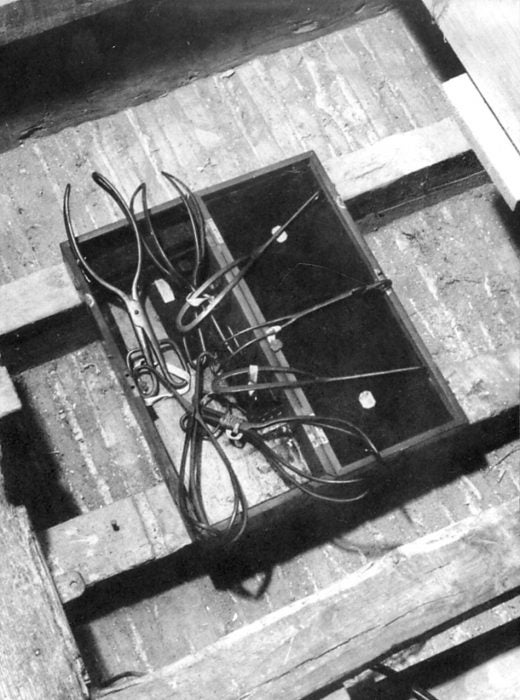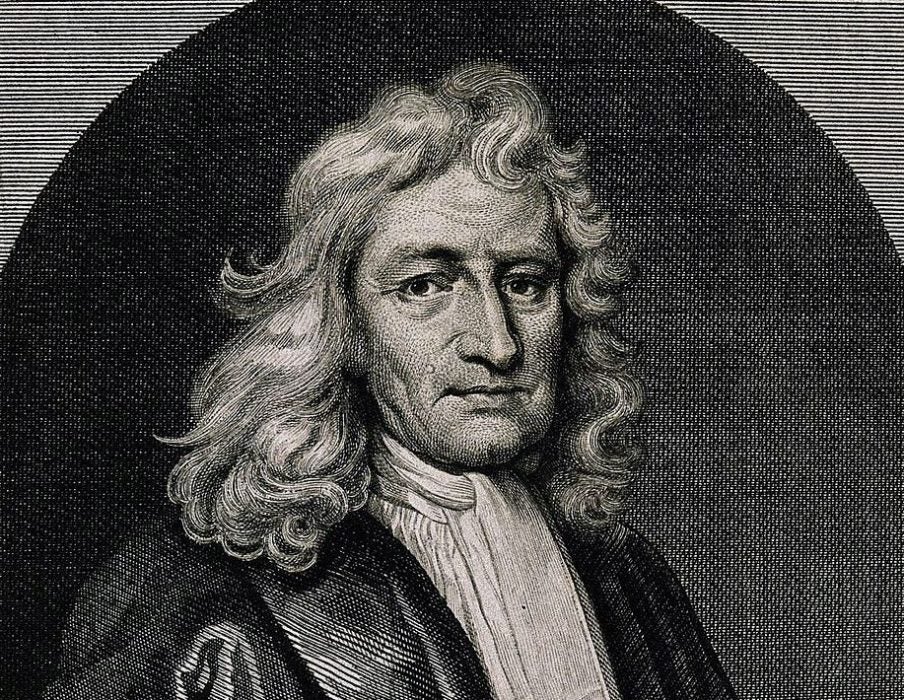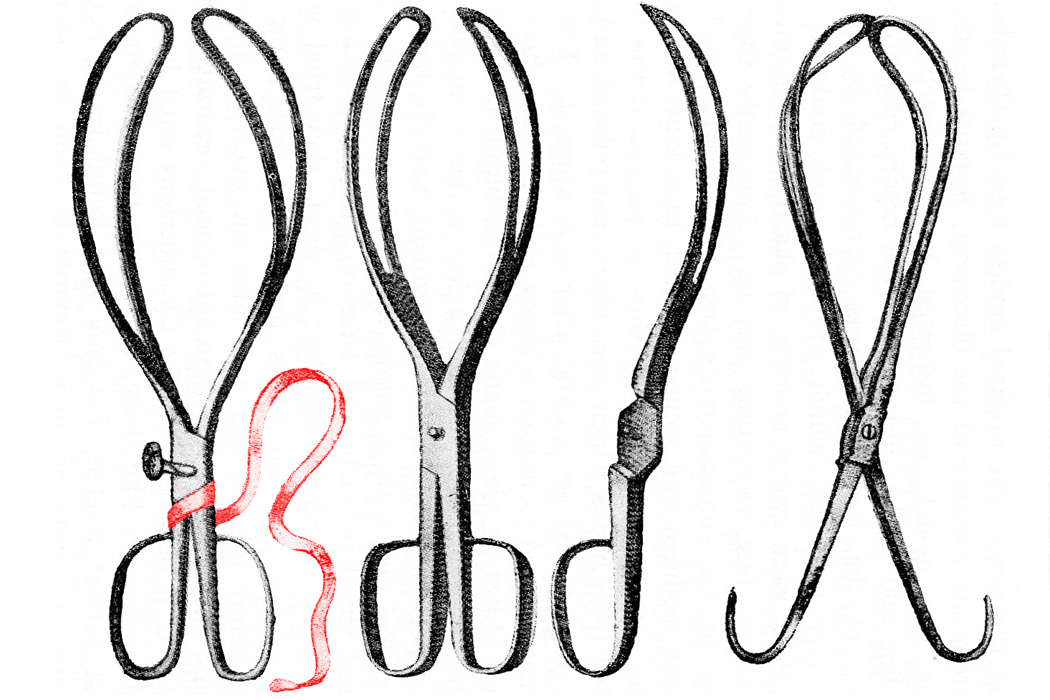Obstetric forceps were invented in the 1600s, but weren’t widely used during childbirth until the early 1700s. That’s because their inventors, a family of male midwives, kept them a secret for profit.
After queen-regent Catherine de Medici declared a ban on protestant physicians—part of her campaign against the Huguenots—William and Genevieve Chamberlen and their three children, Peter, Simon, and Jane, fled France in 1569. Soon after arriving in Southampton, England, they had another son, who they also named Peter. (The family suffered “a singular lack of imagination in choosing the names of their children,” observes Professor of Midwifery Rosemary Mander in her 2004 book Men and Maternity.)
The two Peters became barber-surgeons like their father, soon adding midwifery to their repertoire. Peter the Elder set up his practice in London, quickly becoming a celebrated “accoucheur”—the preferred nomenclature for male midwives. He attended both Queen Anne, wife of James I, and Queen Henrietta Maria, wife of Charles I. Peter the Younger joined his brother’s practice in 1600. Most historians believe Peter the Elder invented the forceps around this time, but the exact date and person responsible remains unknown.
“The term man-midwife had derogatory overtones (hence the well-known cartoon of the man-midwife as half instrument-wielding man, half woman…), which explains why the elite man-midwives—in modern terms, the obstetricians—preferred the fancy French term ‘accoucheur,’” the physician and historian Irvine Loudon explained in the Bulletin of the History of Medicine.
The Peters regularly butted heads with medical authorities, incurring fines for skipping the Barber Surgeon Guild’s lectures, which were required for maintaining their licensure. In 1612, the Royal College of Physicians charged Peter the Elder with “illegal and evil practice” for prescribing medicines to be taken internally. Only licensed physicians were supposed to provide such a service. Luckily for him, the persuading influence of powerful allies saw him quickly sprung from jail.
The Chamberlen forceps were created for the purpose of safely extracting the child in the case of a difficult birth. Previous devices, such as crochet-like hooks, invariably ended the life of a child stuck in the birth canal—so the mother might be spared the same fate. Or they were used to deliver an already-stillborn child for the same purpose.
The Chamberlens were always refining their forceps design: The original pair’s riveted joint was nearly impossible to maneuver, so it was replaced with a pin that acted as a pivot. Finally, the Chamberlens found that tape wound through a hole in each blade at the point where they crossed was the most flexible design. The forceps had a cephalic curvature to cradle the infant’s head and were fenestrated to provide a good grip and lessen compression. The brothers Chamberlen kept their forceps, their treasured family secret, in a huge chest adorned with gilded carvings.

“It always took two of them to carry the box, and everyone was led to believe that it contained some massive and highly complicated machine,” British pediatrician Peter Dunn noted in a December 1999 article. “Only the Chamberlens were allowed in the locked lying-in room, from which the terrified relatives heard peculiar noises, ringing bells, and other sinister sounds as the ‘secret’ went to work.”
Inside the lying-in room, the Chamberlens blindfolded the expectant mother before the chest was opened, so she would not see the tool. The man-midwife covered the woman’s bottom half in blankets. He would then complete his work by touch, since looking under the blankets would have been improper. The blankets offered their secret tool further protection from the curious eyes of laboring women.
Female midwives knew to call on the Chamberlens when they encountered a particularly difficult birth. That’s why the men clung to their secret so resolutely: So they could continue to make money by being the only midwives with the proper tools for safe delivery of complicated cases. An epidemic of rickets, which often left women with pelvic deformities, meant that their services were in high demand.
The author Wendy Moore wrote in the British Medical Journal:
The Chamberlens were clever businessmen. They advertised their services and shielded their invention from rival eyes by transporting the forceps in a covered carriage and carrying them into the delivery room in a huge box. A whisper of the secret emerged in 1634 when midwives criticised the ‘instruments of iron’ but it was another 99 years before the forceps were fully described.
Among physicians and surgeons in the seventeenth and eighteenth centuries, sitting on trade secrets to ensure maximum profit was a relatively common practice.
There is some speculation about the true origin of the Chamberlens’ forceps. Belgium and France maintain that the Flemish physician Jean Palfyn was in fact the father of modern obstetric forceps. A short entry in the June 1902 issue of the British Medical Journal postulates it may have been Peter’s grandfather who invented them. He was a prominent inventor, known for his wind-propelled carriage creation. It’s also possible the “instrument may have been obtained by purchase [by the Chamberlens] from some obscure and forgotten practitioner,” the author noted. “Certainly the Chamberlens’ treated their knowledge (however acquired) in a very commercial spirit.”
Peter the third, son of Peter the Younger, was one of the few Chamberlens to actually earn a medical degree. But he too found himself at odds with the Royal College of Physicians. They found his flamboyant, “frivolous” style of dress disconcerting, and threatened not to admit him until he adopted the “decent and sober dress” of members. Peter #3 took over the role of physician to the king following his uncle’s death, attending Queen Henrietta Maria during the birth of the future King Charles II.
Peter #3 refused to tend poor patients, only seeing those who could pay him handsomely. He sought to create a midwifery monopoly by offering his emergency services only to birthing women under the care of midwives who had “confirmed” themselves to him. The College found this proposal insolent and boastful, declaring it “based on the presumption that he hath more exact skill than all the grave and learned physicians in the kingdom on those cases.”

After being dismissed from the College for lack of attendance at its meetings, Peter #3 moved his practice to Essex, outside the group’s jurisdiction. His oldest son, Hugh, soon joined his father’s midwifery practice.
Hugh traveled to Paris in 1670 with the hope of selling their secret to the French government. Man-midwives were all the rage there now, Louis XIV having started the trend by employing them for his pregnant mistresses. Hugh told the royal accoucheur, Jules Clement, that he would sell him the tool for 10,000 crowns. Before agreeing, Hugh and his tool were to be put to the test by prominent surgeon Francois Mauriceau: Hugh had to successfully deliver a 38-year-old woman with dwarfism and a deformed pelvis who had already been in labor for eight days. He spent three hours locked in the lying-in room with her, but she died of a ruptured uterus. There would be no sale.
But the trip proved profitable in another way. Hugh obtained a copy of Mauriceau’s popular textbook Des Maladies des Femmes Grosses. His subsequent translation, The Accomplisht Midwife, published in 1673, proved wildly successful, becoming the standard textbook on midwifery in England for the next 100 years.
In the preface, Hugh references the family secret:
My father, brothers, and myself (tho’ none else in Europe as I know) have… long practiced a way to deliver women… without any prejudice to them or their infants; tho’ all others (being obliged, for want of such an expedient, to use the common way) do and must endanger, if not destroy one or both with hooks. By this manual operation, a labour may be dispatched (on the least difficulty) with fewer pains and sooner, to the great advantage and without danger both of woman and child.
Since French man-midwives were also exceptionally interested in increasing their profits, Hugh’s text encouraged practitioners to attend as many births as they could, not just complicated cases. It was through secrecy and self-professed superiority that the Chamberlens and other man-midwives distinguished themselves from traditional female midwives. They sold themselves as knowledgeable men of science, with better skill and more advanced tools than their women rivals.

Though obstetric forceps have saved many lives, they were not altogether harmless. “On the one hand, we have it urged by some authorities that the application of the forceps by the general practitioner is often too long delayed, resulting in a loss of fetal life which might be prevented by the timely use of the instrument,” the obstetrics professor J.A.C. Kynoch explained in a 1904 British Medical Journal article. “On the other hand, equally trustworthy authorities have described the forceps as the bloodiest of all obstetric operations.” Kynoch noted that untimely application of the forceps could cause deep cervical lacerations, often rendering women unable to bear more children. He points to statistics from the Rotunda Hospital that reflected an increase in maternal mortality—and a drastic reduction in infant mortality—with the liberal use of forceps.
In 1688, the Royal College of Physicians accused Hugh of practicing without a license. This was despite the fact that Hugh had spent the previous 15 years as a physician to the royal court, attending Queen Mary and the future Queen Anne. He fled to Scotland, and eventually to Holland, where he sold his secret obstetric instruments to the Dutch surgeon Hendrik van Roonhuyse. Hugh purportedly sold him only half a forcep.
Hugh, of course, named his first son Hugh. This Hugh the Younger, lacking his own male heir, is believed to have let slip the family secret as he grew old. Forceps notably similar to the Chamberlens’ came into general use in 1733, five years after Hugh’s death. In 1752, famed English obstetrician William Smellie published his Treatise on the Theory and Practice of Midwifery, in which he outlined proper usage of forceps. His redesigned blades had a pelvic curve and his “English lock” innovation meant that the blades could be inserted into the vagina one at a time.
The medical establishment of the era viewed Midwifery as a lower-status job—that is, it was one male medical practitioners didn’t mind women occupying. But with the introduction of obstetric forceps, more men were drawn to the field. Only Barber Surgeon Guild members were permitted to use such surgical tools, and only men were permitted into the Barber Surgeon Guild. By the 1770s, man-midwifery had become part of the medical establishment, and not just among the rich.
Want more stories like this one?
The original Chamberlen delivery tools were discovered in 1813 under a trap door in the attic of the Chamberlens’ Essex practice. Along with four pairs of forceps, there were levers, filets, and hooks. According to Rosemary Mander: “It would not be an understatement to suggest that these four generations of one family were largely responsible for the move of childbearing out of the domestic sphere where women were responsible for their own and each other’s care into the hands of men.”
Man-midwifery assumed its final form when it assumed the moniker “obstetrics.” And so, thanks to the Chamberlens’ contribution, patriarchy and paternalism began to infiltrate the birthing room. “Whereas birth had been women’s business which was undertaken in a social setting in a domestic context, the arrival of men into the birthing sphere converted it into a scientific, pseudo-medical phenomenon with unlimited scope for intervention,” Mander wrote. This changeover is traceable to the Chamberlens: “Four generations of this dynasty oversaw the initiation of crucial and fundamental changes in the practice of midwifery.”







